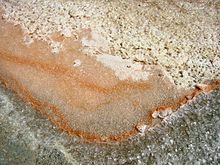
Fleur de sel ("flower of salt" in French; French pronunciation: [flœʁ də sɛl]) or flor de sal (also "flower of salt" in Portuguese, Spanish and Catalan) is a salt that forms as a thin, delicate crust on the surface of seawater as it evaporates. Fleur de sel has been collected since ancient times (it was mentioned by Pliny the Elder in his book Natural History), and was traditionally used as a purgative and salve. It is now used as a finishing salt to flavor and garnish food.[1] The origin of the name is uncertain, but is perfectly in line with both meanings of fleur:[2]flower, and the surface of something.[3] The salt crust forms flower-like patterns of crystals which may contribute to the name.
Fleur de sel is a highly sought after salt, used globally in high end kitchens due to its long-lasting flavor. Properly harvested fleur de sel costs hundreds of times more than table salt due to the difficult-to-master harvesting technique and high demand globally.
- ^ Green, Denzil. "Fleur de Sel". Cook's Info. Retrieved 30 July 2016.
- ^ "Fleur". 24 August 2023.
- ^ cognate with french verbs AFFLEURER and EFFLEURER